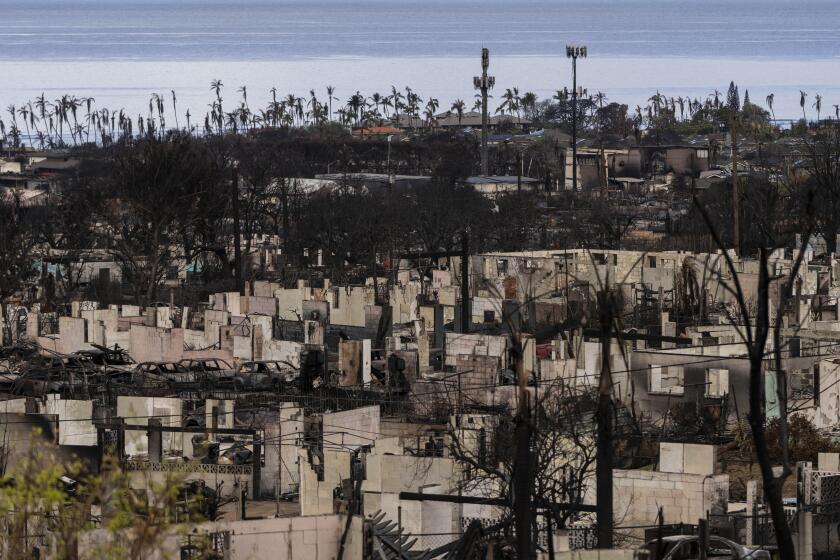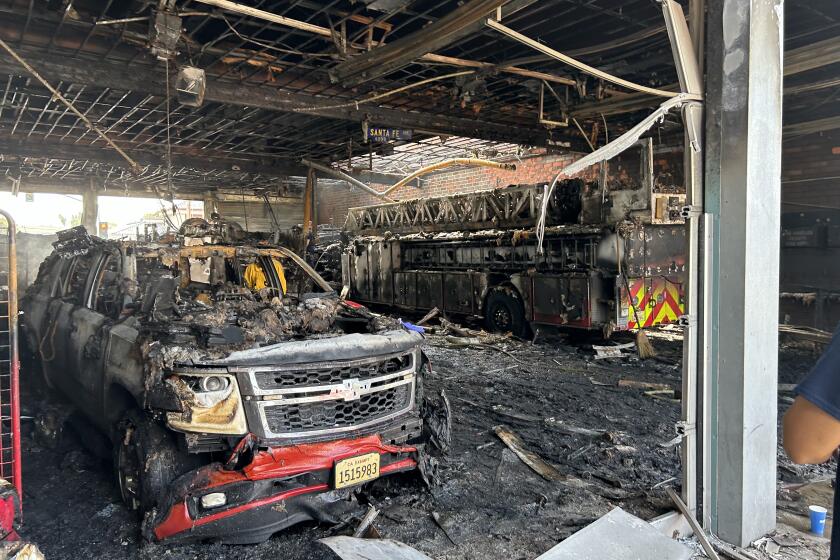Home? Not yet
FOR some Southern Californians, the notion of being home for the holidays is a particularly poignant wish -- the same one they had last year. Although the ashes from the disastrous wildfires that swept from San Bernardino to San Diego counties two years ago have long turned cold, many fire victims are still trying to put their lives back together.
Those who lose homes face a tough choice: Rebuild and manage a daunting construction project while making do in temporary quarters, or move on and start anew?
Critical to their decisions are the size of insurance settlements, the availability of other assets, help from family and community and personal fortitude.
“You have to decide what your tolerance is for pain,” said Lila Hayes, a San Diego computer consultant and volunteer support-group coordinator for victims of the 2003 Old fire, which destroyed 550 homes, including her mother’s house on the outskirts of San Bernardino.
Hayes knows some owners who have yet to break ground because they’re still sparring with their insurance companies. “This is not a fast process.”
Four Southern California homeowners who lost their homes in the last three years -- two in the ’03 wildfires and two to other fires -- described their ordeals as complex and stressful. Here are their stories:
After the Old fire destroyed her home of 38 years, Charlotte Crandall visited the site almost every day.
“I would go there and just park in the driveway,” she said. “Visit the ashes. I took the day off while they excavated. They loaded up my life and hauled it up to the dump.”
Aided by Hayes, her daughter and other family members, the 58-year-old instructional assistant was determined to rebuild.
The house had been the first and only home she had owned. It was a three-bedroom, one-bath, 1,000-square-foot residence in the Del Rosa neighborhood, where she and her former husband had reared their daughter and three sons.
Shortly before the fire, her insurance company estimated the cost to replace her home at $108,000. After speaking to an independent contractor, however, Crandall learned that it would cost double that amount to rebuild. She hired an attorney, sued her insurer and recovered the $220,000 it is costing for reconstruction.
During the process, she lived first with one son in nearby Highland, then in a trailer on her burned-out lot and, when construction began, in the trailer on her parents’ rural Highland property.
Crandall continues to pay her $350 monthly mortgage and holds fast to a vision of a new and improved home, slightly larger, with two bathrooms, radiant heat and solar water heating. She plans to have her parents move in with her once the home is completed in March, 29 months after it burned.
“This was my property,” Crandall said. “I can’t afford to move anywhere else. And there’s nowhere else I’d rather be.”
When an arsonist torched the Tuthills’ home in Julian, in the mountains northeast of San Diego, in 2002, Chris Tuthill recalls that she and her husband, Bruce, were forced to reassess their future and answer an unexpected question: “What do you want to do with the rest of your life?”
The couple, who are in their 50s, had envisioned spending their retirement on their 4-acre spread.
After the fire, however, they found their insurance coverage was insufficient. Rebuilding would mean taking on additional debt and working more as they neared retirement, rather than slowing down.
So the couple borrowed from their savings, built a bigger home, then sold it for more than $500,000 to recoup what they could. They also sued their insurer, reaching a settlement they declined to discuss for legal reasons.
They then decided, regretfully, to relocate to a less expensive part of the country. In April, with the equity they recovered from the sale of their house, they purchased a three-bedroom, two-bath home on 4 acres in Mountain Home, Ark., for $120,000 and replenished their savings.
A former firefighter eventually pleaded guilty to two counts of arson that destroyed two houses and damaged the Tuthills’ home.
Tuthill, a financial advisor, wound up her work this month as a bookkeeper for the Julian-based San Diego Firestorm Community Recovery Team, which assists county victims of the 2003 wildfires. She recently joined her husband, an actor, in Arkansas.
“Six hundred of our friends and neighbors lost their homes in the fires,” she said. “What could we do other than help?”
They’re still rebuilding
Rebuilding her Rolling Hills Estates home might be a smart financial move, but Ann Nomicos wonders if it’s worth the price. The retiree spends her days supervising the construction, much like a daily job.
On Mother’s Day 2003, Nomicos and family members were sent running from their dinner by an electrical fire that started in the garage and quickly engulfed the 2,500-square-foot house.
Thirty months later, the couple are still rebuilding. They live in the small guesthouse of a friend, seven miles from their lot. Nomicos’ husband, Eugene, a retired surgeon, suffered smoke inhalation during the fire and has been unwell since.
At first, they assumed the wisest course was to rebuild, even though they were underinsured, she said. Had they chosen not to rebuild, the insurer would have paid them $100,000 less. So the couple invested $300,000 of their savings to improve the home’s resale value, adding a three-quarter bath, a new master bath, an enlarged walk-in closet and a three-car garage. They believe the additions will bring the home up from its $1-million value before the fire.
Even with the potential increase to their net worth, Nomicos said that if she had it to do over again, she would not rebuild.
“I would probably buy a smaller house that’s all ready to go so we would be freer to do what we wanted to do,” she said. “Everything would have been better. We had no idea.”
Battled to prove losses
Amelia Hermann credits the advice and moral support from the Old Fire Recovery Group with helping her family find a happy ending after the loss of their 4,000-square-foot home in the 2003 San Bernardino County wildfire.
Following the advice of experts aiding the group, Hermann and her husband, Jim, focused on getting their insurer to pay them for what they lost, then considered whether to rebuild.
They spent hours listing every item of personal property they could think of on 60 pages.
“They make it so complicated and arduous that you’ll just give up,” Amelia Hermann said. In the end, however, “it really paid off to be diligent.”
They also hired an independent contractor to help prove the extent of their losses, sifting through the debris with them to confirm the quality of building materials.
While they tussled with their insurer, the Hermanns lived in a 1,300-square-foot rental property they own.
Then Jim Hermann, who’d long dreamed of a rural home, found a 3,100-square-foot house for sale on 2 acres in Yucaipa.
With the proceeds from the sale of their lot (worth as much as they paid for the house and land 18 years earlier) and the insurance settlement, which they declined to reveal for legal reasons, they purchased the home with cash.
The couple are thrilled with their new home, still large enough to accommodate them and the two of their five children who live at home.
They continue to hear construction horror stories from former neighbors who are still rebuilding. And they count their blessings.
If they had chosen to rebuild? “We’d still be a year away from being in a house,” Amelia Hermann said.
*
BEGIN TEXT OF INFOBOX
After a fire: Get help, but don’t rush recovery
Tips for those who have lost homes:
* Join a community group or go online to find help at www.oldfirerecoverygroup.org, created by Lila Hayes for the 2003 San Bernardino County wildfire victims. The site has information and links to insurance, building and government experts. And she offers steps to recovery in the personal story of her mother’s home rebuilding at www.momshouse.homestead.com.
* Become educated about the insurance claim process. The amount your company offers you can be negotiated. Consumer advocate, attorney and contractor George Kehrer, who lost his home in the Oakland Hills fire, helps consumers get insurers to foot the cost to rebuild. He is executive director of the nonprofit group Community Assisting Recovery Inc., www.carehelp.org, which is currently providing free assistance to hurricane victims. The California Department of Insurance has a consumer hot line at (800) 927-4357. The department’s website, at www.insurance.ca.gov, has a consumer information guide called “Don’t Get Burned After a Disaster.”
* Do not settle quickly with your insurance company, no matter how stressed or overwhelmed you might feel. Those who accept a “payment in full” without taking time to prove the extent of their losses usually receive less than those who wait and work at demonstrating their losses, according to Hayes.
* Even if you plan to relocate, focus on recovering what your insurer owes you for the loss. That includes the painstaking task of listing every item you can remember from your home.
* Consider hiring a private, independent contractor to help prove the “scope of loss,” by verifying the quality and type of building materials used in your home. These contractors charge a flat fee for service, rather than a percentage of your settlement, that can range from $2,000 to $10,000, depending on the size of the home.
* Don’t be in a rush to have the rubble removed. Experts can sift through it for evidence to bolster your case for higher-quality reconstruction.
* Be willing to accept donations and help from friends and community members. The process could be longer and more costly than you ever imagined.
More to Read
Start your day right
Sign up for Essential California for news, features and recommendations from the L.A. Times and beyond in your inbox six days a week.
You may occasionally receive promotional content from the Los Angeles Times.






